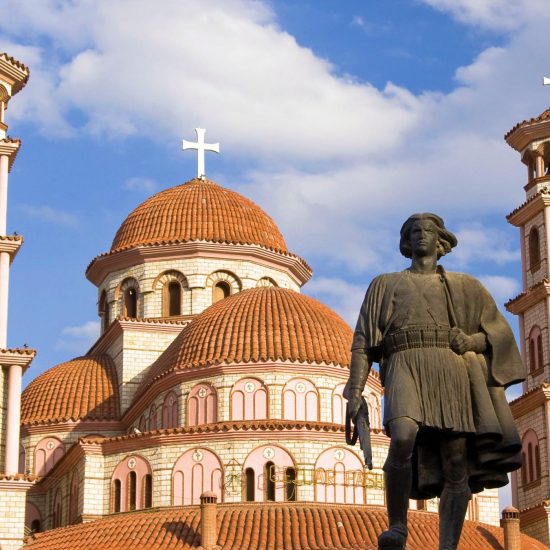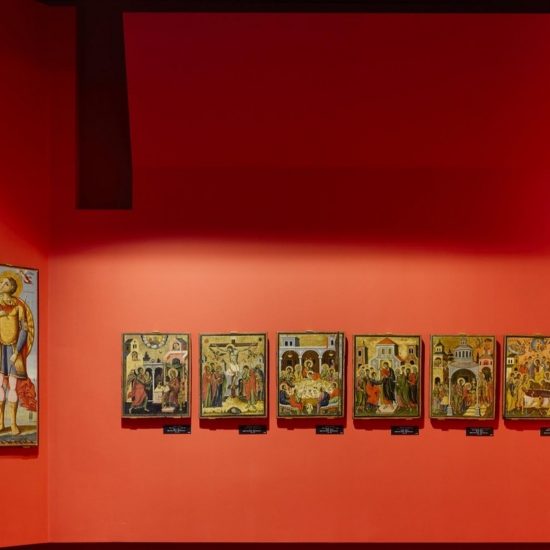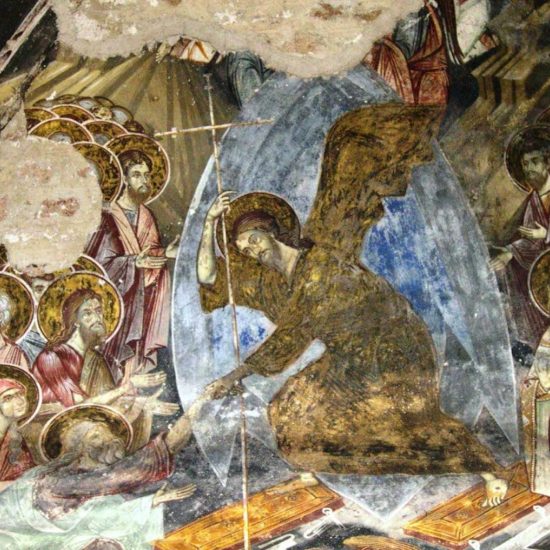Pogradec
You enter the Pogradec region on the national highway, where the road from Macedonia crosses Qafë Thanë. This junction offers a picturesque view of Lake Ohrid, a real gem located between Mali and Tate (Dry Mountain) in the east and the highlands of Mokra in the west. A little lower you can stop on the Lin Peninsula and in the village of the same name, just 25 km from Pogradets. It is said that in ancient times it was a favorite resting place for the parents of the Roman emperor Justinian. In addition to the enchanting scenery, the Lin Mosaic dating from the 7th to 6th centuries BC can be found. This ancient work of art showcases an amazing ensemble of zoomorphic, vegetal and geometric decorations reminiscent of ancient Durrës. The road to Pogradec runs along the shore of the Ohrid tectonic lake, the deepest lake in the Balkans (285 m). This 2-4 million year old lake is under the protection of UNESCO due to its unique value and is home to 17 species of aquatic animals, 70% of which are local and 30% migrants. Ohrid sponge is found only here and on Baikal. On the shore of the lake you will find many restaurants, clubs and comfortable hotels. You should not miss trying the traditional fish dishes, especially the baked speckled trout (Koran in Albanian) as well as the famous pickles. You can also try the different wines on offer, but don’t miss the traditional unique Buta wine or the famous rivers Perla and Moskat from Pogradec. The city of Pogradec was inhabited during the Neolithic period, and subsequently became the home of the Illyrian clans Enkeledzhe and Desarete, who built Pogradec Castle on a hill at an altitude of 870 m above sea level. The city, with its mild climate, is suitable for year-round visits. Before leaving Pogradets, don’t miss Drilon and Tushemisht, just 4-5 km south of the city. The waters of Drilon form a small lake surrounded by beautiful greenery, which makes this area and the neighboring village of Tushemisht a unique oasis of beauty and tranquility. The Pogradec region is rich in impressive and original natural and historical sights. You can visit the attraction – the Kamye rock, which is located in the commune of Dardhas (on the road from Pogradets to Korca, near the village of Osnat). It has a height of 70 m and suddenly breaks out of the surrounding area, like “a ship sailing in a sea of greenery.” 30 km from Pogradets there are archaeological excavations and monumental graves of Selca. Monuments here date back to the 4th century BC just 4-5 km south of the city. The waters of Drilon form a small lake surrounded by beautiful greenery, which makes this area and the neighboring village of Tushemisht a unique oasis of beauty and tranquility. The Pogradec region is rich in impressive and original natural and historical sights. You can visit the attraction – the Kamye rock, which is located in the commune of Dardhas (on the road from Pogradets to Korca, near the village of Osnat). It has a height of 70 m and suddenly breaks out of the surrounding area, like “a ship sailing in a sea of greenery.” 30 km from Pogradets there are archaeological excavations and monumental graves of Selca. Monuments here date back to the 4th century BC just 4-5 km south of the city. The waters of Drilon form a small lake surrounded by beautiful greenery, which makes this area and the neighboring village of Tushemisht a unique oasis of beauty and tranquility. The Pogradec region is rich in impressive and original natural and historical sights. You can visit the attraction – the Kamye rock, which is located in the commune of Dardhas (on the road from Pogradets to Korca, near the village of Osnat). It has a height of 70 m and suddenly breaks out of the surrounding area, like “a ship sailing in a sea of greenery.” 30 km from Pogradets there are archaeological excavations and monumental graves of Selca. The monuments here date back to the 4th century BC The Pogradec region is rich in impressive and original natural and historical sights. You can visit the attraction – the Kamye rock, which is located in the commune of Dardhas (on the road from Pogradets to Korca, near the village of Osnat). It has a height of 70 m and suddenly breaks out of the surrounding area, like “a ship sailing in a sea of greenery.” 30 km from Pogradets there are archaeological excavations and monumental graves of Selca. The monuments here date back to the 4th century BC The Pogradec region is rich in impressive and original natural and historical sights. You can visit the attraction – the Kamye rock, which is located in the commune of Dardhas (on the road from Pogradets to Korca, near the village of Osnat). It has a height of 70 m and suddenly breaks out of the surrounding area, like “a ship sailing in a sea of greenery.” 30 km from Pogradets there are archaeological excavations and monumental graves of Selca. Monuments here date back to the 4th century BC. 30 km from Pogradets there are archaeological excavations and monumental graves of Selca. The monuments here date back to the 4th century BC The Pogradec region is rich in impressive and original natural and historical sights. You can visit the attraction – the Kamye rock, which is located in the commune of Dardhas (on the road from Pogradets to Korca, near the village of Osnat). It has a height of 70 m and suddenly breaks out of the surrounding area, like “a ship sailing in a sea of greenery.” 30 km from Pogradets there are archaeological excavations and monumental graves of Selca. Monuments here date back to the 4th century BC. 30 km from Pogradets there are archaeological excavations and monumental graves of Selca. The monuments here date back to the 4th century BC The Pogradec region is rich in impressive and original natural and historical sights. You can visit the attraction – the Kamye rock, which is located in the commune of Dardhas (on the road from Pogradets to Korca, near the village of Osnat). It has a height of 70 m and suddenly breaks out of the surrounding area, like “a ship sailing in a sea of greenery.” 30 km from Pogradets there are archaeological excavations and monumental graves of Selca. Monuments here date back to the 4th century BC. which is located in the municipality of Dardhas (on the road from Pogradets to Korca, near the village of Osnat). It has a height of 70 m and suddenly breaks out of the surrounding area, like “a ship sailing in a sea of greenery.” 30 km from Pogradets there are archaeological excavations and monumental graves of Selca. Monuments here date back to the 4th century BC. which is located in the municipality of Dardhas (on the road from Pogradets to Korca, near the village of Osnat). It has a height of 70 m and suddenly breaks out of the surrounding area, like “a ship sailing in a sea of greenery.” 30 km from Pogradets there are archaeological excavations and monumental graves of Selca. Monuments here date back to the 4th century BC.
Korcha
The next surprise after the exceptional city of Pogradec is Korca, one of the largest urban centers in Albania. In spring, the main alley is filled with the delicate scent of sturgeon flowers, and in winter, you can enjoy a quiet walk under the snow-covered trees. In 1887, the first Albanian school opened in Korca. During the First World War, French troops took control of the city and it became the autonomous region of Korçë. In 1917, the French Lyceum (one of the most famous schools in Albania) was opened. Apart from its famous history, one should pay attention to the traditional architecture of Korçë with its villa-like houses surrounded by railings and flowering gardens. The area between the boulevards of the Republic and Shen Gerdzhi is very interesting: here, in two traditional buildings of Korça, the Museum of Medieval Art and the Prehistoric Museum are located, displays about 1200 artifacts from the prehistoric, Hellenic, Roman and early Byzantine eras. Other attractions include the historic home of master artist Wangjush Myo and the Bratko Collection Museum, opened in 2003. You can also visit the bazaar (since the beginning of the 20th century), the mosque of Iliyaz Bey. Mirahori (the oldest historical monument of the city, dated 1484) and the Ngjalla e Krishtit (Christ’s Resurrection) Cathedral, one of the greatest cathedrals in the Balkans. The city is known for its characteristic songs called guitar serenades. In the city’s taverns, you can taste local dishes (don’t miss the lacror with onions and tomatoes, as well as tava e korminës), and don’t forget the carnival festival, the biggest festival of its kind in all of Albania. Other attractions include the historic home of master artist Wangjush Myo and the Bratko Collection Museum, opened in 2003. You can also visit the bazaar (since the beginning of the 20th century), the mosque of Iliyaz Bey. Mirahori (the oldest historical monument of the city, dated 1484) and the Ngjalla e Krishtit (Christ’s Resurrection) Cathedral, one of the greatest cathedrals in the Balkans. The city is known for its characteristic songs called guitar serenades. In the city’s taverns, you can taste local dishes (don’t miss the lacror with onions and tomatoes, as well as tava e korminës), and don’t forget the carnival festival, the biggest festival of its kind in all of Albania. Other attractions include the historic home of master artist Wangjush Myo and the Bratko Collection Museum, opened in 2003. You can also visit the bazaar (since the beginning of the 20th century), the mosque of Iliyaz Bey. Mirahori (the oldest historical monument of the city, dated 1484) and the Ngjalla e Krishtit (Christ’s Resurrection) Cathedral, one of the greatest cathedrals in the Balkans. The city is known for its characteristic songs called guitar serenades. In the city’s taverns, you can taste local dishes (don’t miss the lacror with onions and tomatoes, as well as tava e korminës), and don’t forget the carnival festival, the biggest festival of its kind in all of Albania. ) and the Cathedral of Ngjalla e Krishtit (Resurrection of Christ), one of the greatest cathedrals in the Balkans. The city is known for its characteristic songs called guitar serenades. In the city’s taverns, you can taste local specialties (do not miss lacrore with onions and tomatoes, as well as tava e korminës), and don’t forget the carnival festival, the biggest festival of its kind in all of Albania. ) and the Cathedral of Ngjalla e Krishtit (Resurrection of Christ), one of the greatest cathedrals in the Balkans. The city is known for its characteristic songs called guitar serenades. In the city’s taverns, you can taste local dishes (don’t miss the lacror with onions and tomatoes, as well as tava e korminës), and don’t forget the carnival festival, the biggest festival of its kind in all of Albania.
Voskopoya
Historically, Voskopoi has been one of the most important urban centers in the Balkans since 1330. It reached its golden age in 1794, with a population of 30,000 and contacts as far away as Leipzig, Budapest, Venice and Vienna. The city also had 27 churches, an academy, a library, and the first printing house in the Balkans (1720). Visit Shen Prodhomi Monastery, Shen Kolli Church (1721), Shen Tanasi Church, Fietta e Shen Marise Church and Shen Elijah Church, where images of famous Albanian icon painters such as David Selenikasi and Zografi Brothers from Korça are also on the holy mountain Athos, Halkidiki, Greece. Except for the invigorating climate and the pine-scented air,
Pain
Another unforgettable mountainous place is the village of Dardha, 20 km southeast of Korca, at an altitude of 1350 m above sea level. During the winter months there is snow, the air is crystal clear and the water of the village’s numerous natural fountains is clean and invigorating. See unique women’s folk costumes dominated by black and red (the colors of the national flag), visit stone houses that offer hospitality to travelers, and don’t miss tasting the traditional plum crayfish and lacrora na sach (a traditional pie made between two leaves of dough). and baked in a wood-fired oven).




